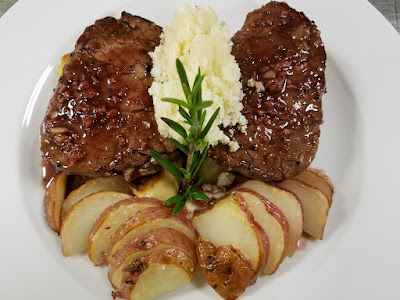The restaurant industry is no stranger to the ebb and flow
of pricing wars, and we are once again on the verge of another significant
battle according to Steven Johnson Grocerant Guru® at Tacoma, WA based Foodservice Solutions®. Over the past two decades, the relationship
between food-at-home and food-away-from-home prices has seen substantial
shifts, often driven by economic conditions, consumer behavior, and inflation
trends. As a Grocerant Guru® with a keen eye on consumer behavior, the signals
today are loud and clear: a restaurant price war is looming, and its
consequences could reshape the dining landscape.
Consumer Spending Trends on Food: 8
Key Points from the U.S. Census Bureau
1.
Rise in
Food-Away-From-Home Prices
Over the last 12 months, limited-service restaurant prices have surged by 4.3%,
while full-service restaurants experienced a 3.8% increase. This has been
compounded by the fact that food-away-from-home
prices overall are 4% higher than the previous year. Historically, such
increases have placed restaurants under pressure to maintain traffic, leading
to competitive pricing strategies.
2.
Stagnation of
Food-At-Home Prices
In contrast, grocery prices have remained relatively stable. Year-over-year, food-at-home prices have only risen by 0.9%,
and in August, they were flat. This 310-basis-point gap between restaurant and
grocery prices is historically significant. For reference, the 22-year
historical average has been a mere 60-basis-point gap. This widening chasm incentivizes
consumers to shift more of their food purchases to groceries, eroding
restaurant traffic.
3.
The Impact of
Economic Downturns
During economic downturns or periods of inflationary pressure, consumers have
historically reduced discretionary spending, which includes dining out. The
2008 financial crisis saw a similar pattern, with many consumers turning to
groceries to save on costs. This resulted in a period of fierce competition
among restaurants to retain customers.
4.
Restaurant Traffic
Declines
Recent research from Circana highlights
that 86% of eating occasions now occur at home, a reflection of the growing
trend of at-home dining. This marks a significant shift from previous decades,
where convenience and rising incomes drove food-away-from-home spending.
Restaurants are struggling to lure customers back, especially when dining out
costs nearly four times as much as eating at home.
5.
Historical Context:
Price Gaps and Their Impact
The current gap between restaurant and grocery prices, at 310 basis points, is
nearing the 2016 full-year disparity of 390 basis points. In 2016, this gap
resulted in the second-lowest same-store sales performance for the restaurant
industry, second only to the pandemic. Price wars erupted as operators slashed
menu prices and launched aggressive promotions to stay competitive.
6.
The Pandemic's
Lingering Effects
The pandemic accelerated the shift toward food-at-home consumption. While
restaurants have recovered in some ways, many consumers have become accustomed
to cooking at home or relying on grocery meal kits. As a result, even with
inflationary pressure easing, restaurants must compete with established at-home
dining habits, pushing them toward pricing adjustments to regain lost traffic.
7.
Pressure on Menu
Prices
Menu prices continue to outpace the overall Consumer
Price Index (CPI), which came in at 2.5% in August. This discrepancy
exacerbates the value perception problem that restaurants face. Consumers,
particularly from lower-income households, are increasingly sensitive to price
hikes, and menu prices rising faster than overall inflation is prompting them
to reconsider dining out altogether.
8.
Consumer Behavior
Shifts
As noted by David Portalatin of Circana, "Meal patterns have shifted as
consumers spend more time at home and adapt to new daily rhythms." This
shift reflects a broader change in consumer priorities. Over the past two
decades, there have been clear periods where consumers, faced with economic
uncertainty, opt for the value and control that grocery shopping provides.
These shifts in behavior typically trigger fierce price competition within the
restaurant sector.
Why a Restaurant Price War is
Inevitable
As consumer spending on food-at-home increases and traffic
at restaurants declines, operators face a critical decision: to protect margins
by maintaining higher prices or to engage in aggressive pricing strategies to
lure customers back. Historically, when restaurant prices outpace grocery
prices by such a wide margin, the industry sees a race to the bottom, with
discounts, promotions, and value-based offerings becoming commonplace.
The following chart illustrates the historical gap between
food-at-home and food-away-from-home prices, highlighting key periods of price
wars.
Historical Gap
Between Food-at-Home and Food-Away-From-Home Prices (2004-2024)
|
Year |
Food-at-Home Price Increase |
Food-Away-From-Home Price Increase |
Price Gap (Basis Points) |
|
2004 |
2.0% |
2.5% |
50 |
|
2008 |
3.5% |
4.0% |
50 |
|
2016 |
1.3% |
5.2% |
390 |
|
2020 |
3.7% |
3.9% |
20 |
|
2024 |
0.9% |
4.0% |
310 |
Think About This
Restaurants are on the brink of a price war fueled by
inflationary pressures, rising operational costs, and changing consumer
preferences. The 20-year historical context shows that when the price gap
between food-at-home and food-away-from-home widens significantly, the
restaurant industry is forced into competitive pricing strategies to maintain
traffic. With the current price gap nearing levels seen in 2016, when the
restaurant sector experienced one of its worst years, the industry must brace
for a fierce battle to retain customers.
As consumers become more cost-conscious and accustomed to
at-home dining, restaurants must find new ways to remain competitive, whether
through aggressive pricing, value-driven meal options, or enhanced customer
experiences. The looming price war may be unavoidable, but those who innovate
and adapt quickly will emerge as the winners.
Don’t over reach. Are
you ready for some fresh ideations? Do your food marketing ideations look more
like yesterday than tomorrow? Interested in learning how Foodservice Solutions® can edify your retail food brand while
creating a platform for consumer convenient meal participation, differentiation
and individualization? Email us
at: Steve@FoodserviceSolutions.us or visit us on our social media sites by clicking the
following links: Facebook, LinkedIn, or Twitter









No comments:
Post a Comment